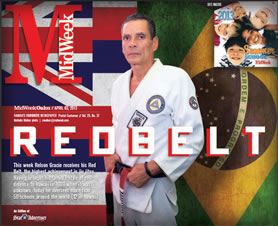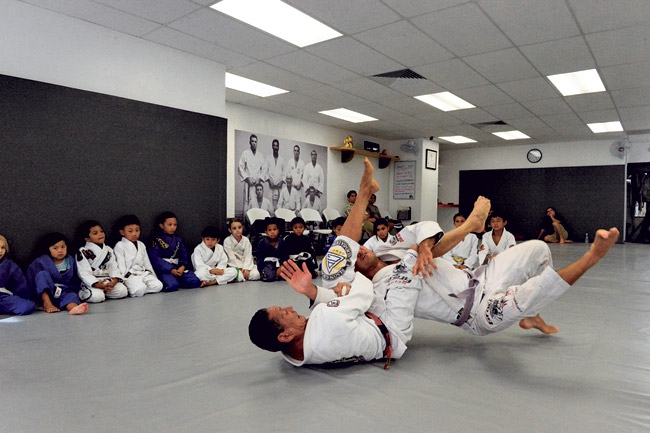Red Belt
This week Relson Gracie receives his Red Belt, the highest achievement in jiu jitsu. Having brought his family’s style of self-defense to Hawaii in 1988 when it was unknown, today he oversees more than 50 schools around the world (12 in Hawaii)
Having fulfilled his father’s instruction to spread Gracie jiu jitsu – he now oversees more than 50 schools around the world – Relson Gracie on Saturday will be awarded a Red Belt, the highest achievement possible
cover_5_relson_gracie
When Brazilian martial artist Relson Gracie moved to Hawaii in 1988, he had one student and struggled to find more. Since then, however, he’s built an empire of more than 50 Relson Gracie Jiu Jitsu schools around the world, including 12 in Hawaii.
On Saturday, the Hawaii Kai resident will be promoted from 8th Degree Red-Black Belt to Red Belt, the highest ranking in Gracie Jiu Jitsu. The promotional ceremony takes place in the Kaiser High School gymnasium at 1 p.m., followed by Gracie’s first seminar as a Red Belt.
“Before Hawaii, I lived in Monterey, Calif., for three years, and then my friend Carlos Valente brings me to Hawaii to teach private out of his garage in his home in Niu Valley,” recalls Gracie. “But I come to Hawaii and I had a little problem to teach jiu jitsu because (at that time) people really don’t know jiu jitsu. People never hear of jiu jitsu before.”
Born and raised in Brazil, Relson (pronounced “helson”) is the second oldest son of the late Grand Master Helio Gracie, who is credited for innovating the jiu jitsu he learned from Japanese jiu jitsu champion Mitsuyo “Count Koma” Maeda. Helio, along with his brother Carlos, then founded Gracie jiu jitsu, commonly referred to as Brazilian jiu jitsu. In 1985, at his family’s request, Relson moved to America to spread the teaching of Gracie jiu jitsu – which he firmly believes is the best form of self-defense in the world.
But it wasn’t until his time in Hawaii, and his brother Royce’s debut in UFC (Ultimate Fighting Championship), that his enrollment grew exponentially.
In 1989, Relson started teaching out of his house near Kalani High School and at the University of Hawaii, where his students included people from the U.S. secret service, FBI, DEA, police and fire departments and military. As Royce (who Relson coached) continued to dominate in UFC in the early 1990s, the popularity of Brazilian jiu jitsu skyrocketed. By 1996, Relson outgrew his space at UH with 700 students and a waiting list of about 150, and opened the Relson Gracie Main Academy on Waialae Avenue.
Today, it’s hard to keep count of Relson’s students and schools, which are run by his Black Belts. On the Mainland, there are 40 schools spread throughout Arizona, California, Colorado, Florida, Georgia, Kentucky, Maryland, Mississippi, New Mexico, New York, North Carolina, Ohio, Pennsylvania, South Carolina, Texas and Virginia. He also has schools in China and Brazil, where he plans to build a jiu jitsu camp, and says more schools are in the works, including one opening on Kauai soon.
Now retired from competition (he ended his career undefeated after 22 years as Brazilian national champion, and a fight record of 138-0), Relson regularly travels across the world for seminars. He recently conducted 43 seminars over 45 days on the Mainland.
“I come home, spend a month here, cross my legs, watch TV and babysit (my grandchildren),” he says.
A father of five and grandfather of three, Relson celebrated his 60th birthday last Thursday and says he’s single, looking for a wife and wants to have five more children.
And while he no longer fights or accepts challenges (noting he ran away from his 139th fight when about 10 guys tried to mob him in Waikiki last year), he remains passionately devoted to continuing his family’s legacy.
During a recent visit to Relson Gracie Waterfront Jiu Jitsu in downtown Honolulu, Relson shows he’s still as sharp as a tack, quickly pointing out mistakes he sees, and demonstrating moves while easily flipping guys half his age and double his size.
“Anybody can do it,” he says. “My jiu jitsu is for kids, women, people who are weak, skinny, fat. It’s designed for defending yourself in a survival situation where there are no rules, to save your life in the streets.
“I recommend jiu jitsu for kids in a sports way because it makes your kids sleep good, healthy, eat well, be humble and protect each other.
“As soon as I could walk I was in a gi, on the mat, trying to pass the bar. And it’s the same way for my children and grandchildren. And my daddy (who passed away in 2009 at age 94) did jiu jitsu into his 90s.”
Watching Relson interact with the keiki, it’s evident he has a genuine love for children.
There’s also a visible joy as he watches the Gracie jiu jitsu tradition continuing its course with the next generation.
He’s also proud to point out that Hawaii has some of the best Gracie jiu jitsu in the world, as well as more medals than any other state.
In 1997, Relson took a team from Hawaii to the World Brazilian Jiu Jitsu Championships in Rio De Janeiro, and made history when two of his students, Kendall Goo and Kelly Matsukawa, took first and second place in the Adult Blue Belt Pessidissimo division.
“After Brazil, Hawaii is the second place in the world with the most medals,” he says.
Currently, Relson has awarded about 53 black belts in the U.S., including 18 in Hawaii.
“My daddy sent me to spread jiu jitsu around the world,” says Relson, who estimates he’s worked with more than 10,000 possibly even 15,000 people in his life so far.
“I prefer Hawaii because of the waves and the climate.
Also, you have your whole fruits because I have my Gracie diet too. I think my mission (from my dad) is complete because of my results through hard work, loyalty, and because all these people in Hawaii take care of me, teach me aloha, support me and keep me humble.”
Relson will conduct his last seminar as a Red-Black Belt on Friday, April 5 at the University of Hawaii at Manoa (in the Athletic Complex Studio 4) from 7 to 8 p.m. Cost is $50 per person. There will be autograph and photo opportunities following the seminar.
Then on Saturday, April 6 at 1 p.m., Relson will receive his Red Belt in the Kaiser High School Gymnasium. Admission to the promotion ceremony is $10. He will then conduct his first seminar as a Red Belt at 2 p.m. Cost is $50 per person. Tickets are available at relson.eventbrite.com or relsongracie.com/relson-promotional.
Also, Relson’s brother, Rorion, will lead a seminar on the Gracie Diet (Saturday, April 6) from 7 to 8 p.m. at the Ilikai Hotel. Tickets are $50 per person or $75 for the seminar plus the Gracie diet book and special shake.
On Sunday, April 7, a family barbecue and beach day is scheduled from 9 a.m. to 5 p.m. at Kapiolani Park (sites 6, 7 and 8, across from Kaimana Beach). Lunch will be served from 11 a.m. to 1 p.m. The public is invited. Cost is $10 or bring your own lunch.







